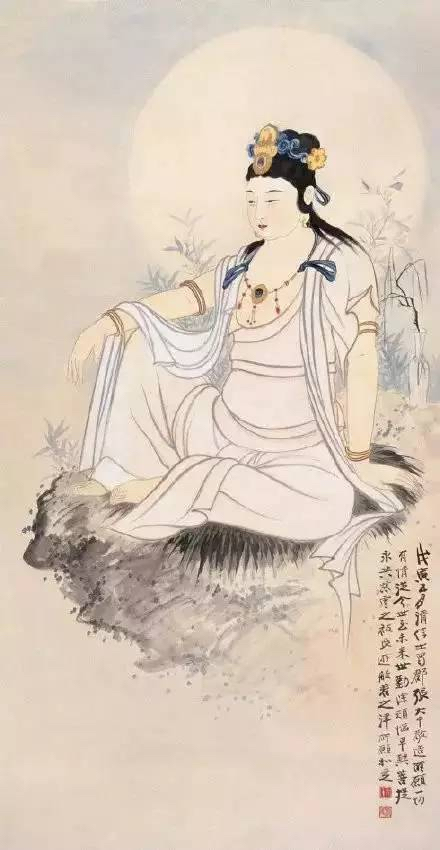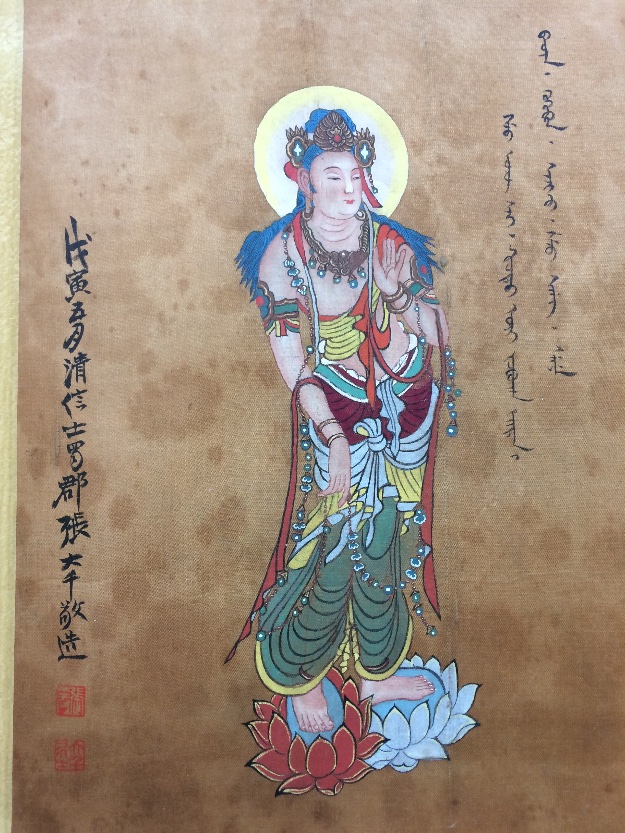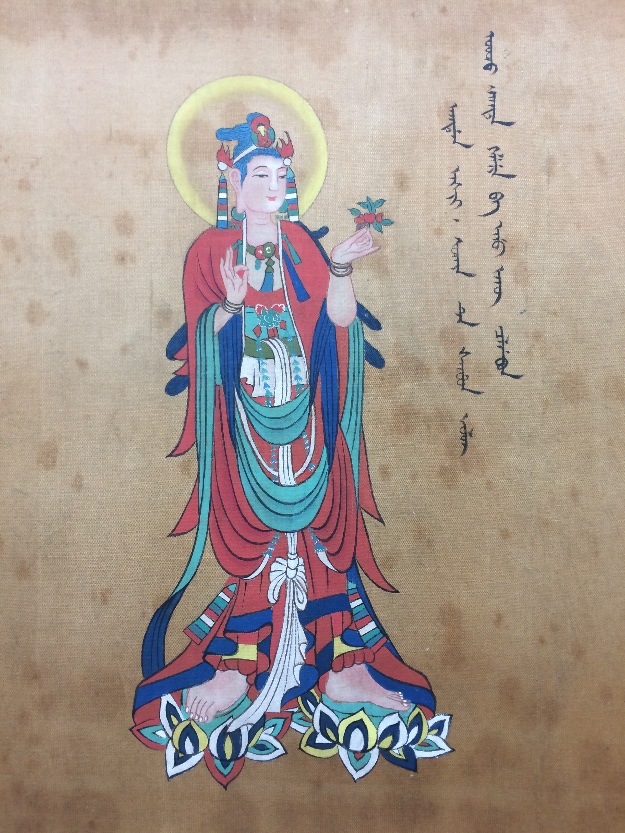Ornamental Manchu: the lengths to which a forger will go
« previous post | next post »
An anonymous collector recently sent me photographs of a handscroll featuring eight manifestations of Guanyin (Skt. Avalokiteśvara), the Bodhisattva of Compassion painted on silk, circa 1940s. A striking feature of this handscroll is that each painting of one of the manifestations is accompanied by a vertical Manchu inscription on the upper right side. The Manchu writing looks genuine, but it has some characteristics that give one pause. The paintings also have some aspects that are disquieting. In this post, l will reproduce only the first and last paintings, but will also provide some other illustrations for comparative purposes.
Each of the eight manifestations is accompanied by a putative Manchu inscription, but only the first has the artist's signature on the bottom left. Since the presumed identity and reputation of the artist are essential for coming to terms with the Manchu inscriptions, let us first dispose of the contents of the Chinese writing. It reads:
Wùyín wǔyuè qīngxìnshì Shǔ jùn Zhāng Dàqiān jìngzào
戊寅五月清信士蜀郡张大千敬造
"Respectfully made in the fifth month of the year 1938 by the upāsaka ('lay devotee') Zhang Daqian of Shu Prefecture*."
(*roughly coterminous with Sichuan Province)
Zhang Daqian 張大千 (1899-1983) is one of the most famous Chinese painters of the 20th century. The customary romanization of his name is Chang Dai-chien, and that is how I will mainly refer to him in the remainder of this post.
We may note that Chang Dai-chien indeed referred to himself as "qīngxìnshì 清信士” ("upāsaka" ["lay devotee"]) in some inscriptions of his paintings of Buddhas.
Chang Dai-chien was a truly talented and prodigiously prolific artist, but was also of mixed reputation because of his penchant for copying old masters, for accusations of damaging wall-paintings at Dunhuang Mogao Caves, and other dubious activities. All things considered, we may say that he was a "complex, chameleonic character".
Since Chang Dai-chien is something of an enigma wrapped in a forgery, it's hard (at least for me!) to say definitively whether the eight paintings on the handscroll really are by him or whether they were painted by someone else and attributed to him, though my immediate reaction is that they appear to be forgeries. What interests me the most for the moment, however, is how in the 1940s the creator(s) of this scroll could find someone capable of writing Manchu with such a professional looking hand. Or was someone simply copying from already existing Manchu texts? Still, how could they make it look so genuine — albeit awkward at many points?
These are some of the questions that were swirling through my head as I contemplated the disturbing mystery of the Guanyin handscroll. From my first encounter with the handscroll, I had grave doubts about its authenticity. Is it real Chang Dai-chien? Or is it fake Chang Dai-chien? Or is it Chang Dai-chien fake?
The handscroll begins with an excerpt of the Heart Sutra, written on yellow gold-flecked paper, then come the 8 manifestations of Guanyin. Copying an excerpt of the Heart Sutra at the beginning of the scroll is understandable, since there is a uniquely close association between Guanyin and the Heart Sutra.
Having dealt with the overall format of the scroll, I will now turn to the art historical questions concerning the inscription and the paintings because, while thorny in their own way, they are easier to handle than the problems surrounding the Manchu writing.
My suspicion that the handscroll is a fake Chang Dai-chien was confirmed by a friend who works in antique authentication and art appraisals. The colors and techniques applied here are quite different from Chang Dai-chien's genuine works that are securely authenticated, albeit he is especially famous for his prodigious virtuosity. The same friend found an inscription of a securely authenticated painting by Chang which is very similar to this one, and we suspect that it may be the original source of this inscription:


Left: on a securely authenticated Guanyin painting. Right: on this handscroll.
In comparison with seals on paintings by Chang that have been securely authenticated, the seals on this handscroll are also dubious.
The following portrait of Guanyin, which I'm using as a reference for the inscription and the seals, should be relatively reliably attributed to Chang — it is mentioned by (at least) three catalogs / monographs on the artist. We can see that Chang's Guanyin painting style here is completely different from that on the handscroll, although they claim to be painted in the same year. In 1938, Zhang Daqian escaped from the Japanese army and fled from Beijing to his hometown in Sichuan — at that time, he had not visited Dunhuang yet and had not learned from those Tang (618-907) murals at Dunhuang.

One can see from the brushwork, the coloring, and everything else about this painting that it is much finer than the paintings on the handscroll with eight manifestations of Guanyin attributed to Chang Dai-chien above. Its great value is also attested by the fact that it is being auctioned for an estimated 2,200,000-3,200,000 RMB (see this website, where you can examine closeups of the painting with an electronic magnifying glass).
Tianyi Zhang, who has undertaken a thorough study of Chang Dai-chien's painting activities at and around Dunhuang, offered these remarks concerning the handscroll under discussion:
Thank you for sharing these paintings with me. First of all, among all Zhang Daqian's copies of Dunhuang murals, I haven't encountered any that have Manchu script, and I've never read anything about him knowing the Manchu language. So it makes sense that the Manchu writing on the handscroll is fake. Also, judging from the painting style and the quality of the images on the pictures that you sent, I don't think they are from Zhang Daqian himself. The facial features of these Guanyin and the colors applied are very different from the works of Zhang Daqian I have seen. More importantly, the signatures on these works are also completely different from the works I've seen. I am attaching some of Zhang Daqian's signatures here, you can see some obvious differences in the writing style, the content of his signature, and also the different ways of writing his name. [VHM: Attachments omitted for this post.]
Now that we have covered the basic art historical questions concerning the handscroll, we may turn to the problem of the Manchu inscriptions.
From a Manchu specialist who is away from his library at the present moment:
At first sight this looks (mis)copied from a Manchu translation of the Heart Sutra (or perhaps some other scripture with overlapping passages) by someone not literate in Manchu.
From another Manchu specialist:
To a practiced eye, the ductus is clearly that of someone who did not know the language and was trying to copy writing he didn’t know.
From an anonymous Manchu philologist:
What a curious find! I know nothing about this artist, but as for the Manchu, I don't think it would have been difficult to find people who could write the language in Beijing in the 1940s. Bannermen* who went to school before 1911 would have learned to write Manchu, and there are examples of such individuals being active into the 1940s and even early People's Republic.
That said, I'm not sure that I agree that this piece of Manchu is very well written. It looks neither like the standard script written with a calamus, as used in the Manchu palace memorials, for example, nor does it look like the cursive Manchu script as written with a Chinese brush and seen in many manuscript books. The text is certainly in the Manchu script, and not Mongolian, since there are Manchu diacritics present. But it looks like gibberish to me. Some letters are not connected properly, and others occur in combinations not allowed in Manchu. I cannot make out a single Manchu word, except a genitive -i. None of the words have a Manchu verb ending. Sometimes the Manchu script was used to write Chinese, in which case every Chinese syllable would be written as one word. But some of these words (e.g., "seye" [?] at the bottom of the line furthest to the right) have two syllables. Given what you say about the provenance of paintings attributed to this artist, I'm tempted to say that this was written by someone who did not know Manchu but simply wanted it to look like Manchu. Very curious indeed…
[*The Eight Banners (in Manchu: ᠵᠠᡴᡡᠨᡤᡡᠰᠠ jakūn gūsa, Chinese: 八旗; pinyin: bāqí) were administrative and military divisions under the Later Jin and the Qing dynasty of China into which all Manchu households were placed. In war, the Eight Banners functioned as armies, but the banner system was also the basic organizational framework of all of Manchu society. (source)]
From Stephen Wadley:
It looks like no Manchu I have ever seen. It doesn't look to me to be Mongolian either. I would suspect the person didn't know Manchu and simply wrote Manchu-like letters on the scrolls. Some come close to looking like Manchu words, a couple are indeed Manchu words but don't make any sense in the spots they are in. For example, the last scroll's first word looks like akdan 'trust,' but it is written with a front "t" instead of a back "t." The last three words look a little like buya baita de "with an insignificant matter"[?] but the buya has two teeth where it should have a circle, the baita has a dot where it shouldn't, and the de doesn't have a dot where it should. If it is some sort of Manchu (which I doubt) it is a type I don't know about.
From Pamela Kyle Crossley:
Well, I'm admitting to being perplexed by this. The script is certainly an attempt at Manchu — more likely than an attempt at Mongolian, I should say. One of the Manchu names for Guanyin — Guwan, but written more like Guyan — is here, but not the Mongolian name for Guanyin. I believe there was an original Manchu text from which this was copied by a person who did not understand the script or language. They got a few words right, and there are a few short words that are identifiable Manchu, though they don't make sense where they are. A majority of the letter combinations are impossible, either in known words or unknown words. I think there was an authentic text from which this was copied. A person knowing Buddhist iconography would know whether they are all Guanyin or not. I looked for the names of a few other Buddha emanations but they are not here (or are impossible to recognize). Hard for me to believe that Zhang Daqian would really have had anything to do with it, but I suppose not impossible. He was examining (and copying) Dunhuang art about the time this seems to have been painted, though so far as I know there isn't any Manchu art at Dunhuang. He was a friend of Puru* so perhaps saw Manchu Buddhist devotionals like this.
[*Puru (artist) (1896-1963), also known as Pu Xinyu, artist and cousin of China's last emperor Puyi (1906-1967).]
Kicengge, a living Manchu speaker, writer, and teacher of Sibe descent (Sibe language and people) from the Ili River valley in northern Xinjiang, provided this striking identification of randomly placed identical terms in the Manchu writing on the handscroll:
Q.E.D.
Selected readings
- "Manchu illiteracy" (4/14/16)
- "Manchu film" (12/31/16)
- "Manchu 'princess' speaking English"
- "Sibe: a living Manchu language" (9/30/17)
- "Manchu loans in northeast Mandarin" (10/7/13)
- "A rebirth for Manchu?" (1/16/16)
- "Manchu, Former Empire’s Language, Hangs On at China’s Edge" (1/11/16)
- "In Song, a Remnant of China’s Former Imperial Language" (1/14/16)
- "Sino-Manchu seals of the Xicom Emperor" (2/12/20)
- "Uyghur as ornament" (9/19/13)
- "Pentalingual street signs in Kashgar" (7/12/20)
- "Gibberish Uyghur" (9/28/09)
- "Gibberish Tibetan" (10/6/16)
[Thanks to Juha Janhunen, Mårten Söderblom Saarela, Mark Elliott, Gertraude Roth Li, Jichang Lulu, Leqi Yu, Yijie Zhang, Chenfeng Wang, Tong Wang, and Zihan Guo]



John Huntington said,
April 25, 2021 @ 11:13 am
Victor, The garish colors, the overstated flesh shading, and the crisp over sharp lines of the robes characterize the painter as a very low rank copyist. About 40 years ago I visited Yu-min Li (a former student who was at that time the deputy director of the Painting collection at in the palace museum Taiwan) where she took me to a shop in which there was an exhibition of 20th century copies of both Dunhuang and Tibetan painters. The images were nothing like these low quality things. Manchu inscriptions or not (I happily know nothing of Manchu except on coins). In my world, the images of the forms of Avalokiteshvara themselves tell the a simple story, "tourist trap" or "fake".
Tianyi Zhang said,
April 25, 2021 @ 11:20 am
I found it very interesting that when the forger was copying the signature and the time on the forgeries, he did not consider the fact that Zhang Daqian had never set foot in Dunhuang in 1938, which means these Dunhuang-style Guanyin portraits are impossible to be painted before 1941. Also, even the original inscription and the forgery inscription are very similar, I think Zhang's calligraphy is obviously much better than the other one.
And I wonder why this forger decided to put those Manchu-like characters on the forgeries. Do you have any possible answers to this?
Michael Watts said,
April 28, 2021 @ 12:02 am
This question is tangential at best, but I've been wondering about how Guanyin (or another personage) is identified as the being depicted in an image. Take the genuine painting above — what is it that tells us this is Guanyin? Accessories? (Clothing / crown… ?) Motif (Gazing out from in front of the moon?) Pose? Does the inscription specify it (as the text of the fake scroll seems to do implicitly by quoting the Heart Sutra)? If so, would the character be identifiable if the inscription were taken away?
Jichang Lulu said,
April 28, 2021 @ 8:11 pm
I (sadly not a Manchu specialist) guessed above that the text on the handscroll might be a poor copy of a Manchu Heart Sutra.
One may compare (a) the Manchu text on the scroll, read in the order 2, 3, 5, 4 (where 1,…,5 are the components of the image prepared by Professor Kicengge) with (b) some of the Manchu in one of the polyglot versions of the sutra reproduced by Fuchs (Die mandjurischen Druckausgaben des Hsin-ching (Hṛdayasūtra)) and transcribed by Hurvitz (“Two polyglot recensions of the Heart Scripture”), namely a passage on pp. 48 f. of Hurvitz. (I haven't been able to consult the Fuchs.) The source of the miscopied text would then be:
gemu akū kai. tuttu ofi jobolon. eiten-i banjin. gukubun. songko gemu akū sure ulhisu akū. bahabun akū. baharakūngge inu akū kai. a Šaribudari. tuttu ofi bodisadu sa bahabun akū turgunde. barandza baramida de akdama nikefi gūnin de dalibun akū ojoro jakade. gelere ba inu akū calgabun
This admittedly takes more than a bit of imagination, since hardly any words on the scroll legibly match the ones they're assigned under this correspondence. This also assumes that the artist copied a short fragment of the above twice, in two different ways.